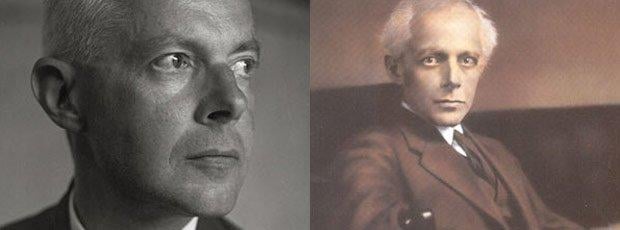One of the most celebrated early 20th-century composers. He collected and studied Eastern European folk music, which became the basis of his mature compositions.
Vital Statistics
Born:
Nagyszentmiklós, Hungary, March 25, 1881
Died:
New York, September 26, 1945, of leukemia
During Lifetime:
Following the collapse of the Austro-Hungarian empire after World War I, Hungary’s government was taken over by communists, who were then ousted by the military in 1920. They instituted Europe’s first nationalist authoritarian regime and eventually entered into alliance with Nazi Germany. With their defeat in World War II, Hungary again became communist in 1945, dominated by the Soviet Union.
Biographical Outline
1899 : Bartók enters the Budapest Academy of Music (now the Liszt Academy), where he is known as a star pianist. 1906 : Alongside his colleague, Zoltán Kodály, Bartók begins to collect, transcribe and anthologize Hungarian folk songs His piano career stalled, Bartók accepts a position on the piano faculty of the Budapest conservatory, which he holds until 1934.1910 : Bartók’s First String Quartet, Op. 7, premieres. It successfully realizes Bartók’s goal of using folk tunes within his own compositions. Over the next years, he refines this new musical style.1917-18 : Bluebeard’s Castle (1911), Bartók’s only opera, successfully premieres at the Budapest Opera. Deteriorating social conditions prevent Bartók from collecting more folk tunes. By 1918, he has already collected about 10,000, and makes only one more field trip the rest of his life.1919-1931 : Bartók’s performing career unexpectedly takes off, resulting in the composition of much piano music including two piano concertos (1926, 1931), and the publication of his music. He becomes internationally known and enters his most avant-garde musical phase. 1934-40 : Full-time ethnomusicology professor at the Budapest Academy. He edits and oversees publication of 14,000 folk song transcriptions, many of them his own. During his tenure, Bartók produces some of his best-known compositions, including Music for Strings, Percussion and Celesta (1936) and his Violin Concerto (1938). His style becomes steadily more populist as the 1930s wear on. 1940-45 : Bartók relocates to New York. Initially unsuccessful there, he stabilizes his financial situation by 1943 with a visiting professorship at Harvard. In 1944, the Boston Symphony Orchestra, under the baton of Serge Koussevitzky, premieres Bartók’s Concerto for Orchestra, a work that Koussevitzky helped to commission. In his last year he finishes his third piano concerto and nearly completes his viola concerto.
Fun Facts
No fun at parties: Bartók was personally shy. In concert he was cold and uncommunicative, which, of course, didn’t help him get gigs. However, Bartók left behind many recordings of him playing the piano that offer valuable insight into his manner of playing. Man of the World: Bartók was a pan-Slavist and an ardent internationalist. Partly due to his cosmopolitan musical style, which assimilates ethnically diverse influences, Bartók was invited to join a committee for “Intellectual Co-operation” by the League of Nations in 1931. Teaching legacy: Bartók didn’t enjoy teaching, but you’d never know it from his composition list. Two of his major works in the 1930s – 44 Duos for violin, and Mikrokosmos, six books of graded, short pieces for piano – were pedagogical. Among his students were several famous pianists and the pianist/ conductor Georg Solti. Founding a Field: Due to his work with folk melodies, Bartók is regarded as a founding father of ethnomusicology, or the anthropological study of music.
Recommended Biography
Halsey Stevens, The Life and Music of Bela Bartók, 3rd ed., edited and expanded by Malcolm Gillies. (Oxford, 1993). Kenneth Chalmers, Bela Bartók. 20th Century Composers (Phaidon, 1995) Malcolm Gillies, Bartók Remembered (Norton, 1991). Includes interview with the composer’s son, and others who knew him.
Explore the Music
Structural Symmetries: Bartók’s music is famous for all sorts of symmetrical structures. For example, his rhythmic and formal structures often read like musical palindromes. East meets West: Bartók’s music is famous for blending elements from Western classical and Eastern European folk traditions. Piano Music: Bartók composed many of the pieces within Mikrokosmos to teach his son, Péter, how to play the piano. Some of the difficult pieces in this collection, though, are frequently performed as concert pieces.
Recommended Websites
Recordings
Begin at the end: Many of Bartók’s most popular concert works are those he wrote near the end of his life. Working backwards to the first of his popular orchestral works:Concerto for Orchestra (1944) Piano Concerto No. 3 (1945) Sonata for Violin (1944) Violin Concerto No. 2 (1938) Mikrokosmos (1937), selections Sonata for Two Pianos and Percussion (1937) Music for Strings, Percussion, and Celesta (1936) Solo piano music String Quartets:Bartók’s six string quartets are among the greatest of the 20th century. Again working backwards, No. 6 is the place to begin. Nos. 3-5 are challenging, Nos. 1 and 2 are easier. Opera:Bluebeard’s Castle For opera lovers: Bartók’s one opera is brilliant, colorful, with grateful writing for voices. Well worth a listen.
